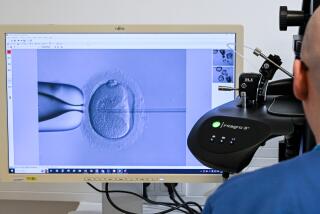HEALTH HORIZONS : MEDICINE :...
- Share via
Sarah Bromley* lies on the operating-room table, fading into a state deeper than sleep. Nurses place sheets across her body, leaving an opening over a small section of her lower abdomen. The surgeon, Dr. Joel Batzofin, uses a scalpel to cut a tiny hole in her navel. He inserts a long tube through the incision, pumps Bromley’s abdomen full of air and then attaches a video camera eyepiece to the outer end of the tube. A nurse fiddles with a monitor beside Bromley, and, as the screen vividly reflects each move the surgeon makes, suddenly the “Fantastic Voyage” is no longer just Hollywood invention.
“Here is the uterus and the Fallopian tube,” Batzofin dictates into a microphone as his surgical tools manipulate the slippery interior of the body. “Notice the scarring on the tube from the ectopic pregnancy,” he says.
Another object appears on the screen--a catheter filled with fluid, a liquid containing three potential human lives. The catheter slides into the opening of the Fallopian tube, and Batzofin continues his dictation: “We are placing three embryos into the left Fallopian tube.”
Bromley is undergoing zygote intra-Fallopian transfer, or ZIFT, one of several variations on the test-tube baby-making theme, in which a zygote, meaning a fertilized egg or embryo, is transferred from a petri dish to a Fallopian tube. If all goes well, nature takes over, carrying the embryo to the uterus.
It is Bromley’s third attempt at ZIFT at Pasadena’s Huntington Reproductive Center, where Batzofin serves as co-director. The first procedure resulted in an ectopic pregnancy, with the embryo settling in the inhospitable environment of the left Fallopian tube. The second was a success, but Bromley miscarried several weeks into the pregnancy.
Fourteen days after the third procedure--two weeks of waiting on pins and needles--Bromley is greeted with more bad news: None of the embryos took hold in the uterus.
Bromley isn’t alone in her quest or her heartache. One in six couples in the United States has trouble conceiving a child, according to RESOLVE, a national support group for infertile couples. And although the number of people struggling to have a baby has not increased, the congressional Office of Technology Assessment’s 1988 report on infertility disclosed that the number of people seeking treatment nearly tripled between 1968 and 1984.
Twenty years ago, when a couple had trouble conceiving, they were left with very few options: adopt, remain childless or take a chance on the relatively new field of infertility medicine. Today, medical advances keep pace with the demand for help and provide couples with more than a handful of choices. With these alternatives, however, an intimate process once confined to one’s own home has moved to the laboratory and mushroomed in complexity, leaving parents-to-be both hopeful and confused.
Moreover, though statistics have improved since Louise Brown, the first test-tube baby, was conceived in 1978, success rates in the infertility business have been open to debate. For example, while the Office of Technology Assessment estimates that as many as half of the couples seeking treatment came away without a baby, the American Fertility Society considers that figure overly pessimistic. The confusion results in part from the varying approaches to treatment by patients and doctors alike. Some couples may undergo only an initial workup at limited expense, while others are willing to exhaust all avenues, spending a small fortune in the process. At the same time, each physician will scale the ladder of potential therapies at a different pace and diagnose different conditions.
It’s a course many people take haphazardly, not always grasping the ramifications.
The average obstetrician-gynecologist has been trained to deliver babies and treat gynecological illnesses. Specialists in infertility undergo a two-year post-residency fellowship in reproductive endocrinology and infertility. As treatment becomes more popular and profitable, however, those without additional training are claiming infertility expertise.
Says Dr. Richard Marrs, director of the Institute for Reproductive Research at the Hospital of the Good Samaritan: “You can go into any city, into any medical building, and the majority of OB-GYNs today list themselves as obstetricians specializing in OB-GYN and infertility.”
Marrs, who is a reproductive endocrinologist, believes that many physicians are overextending themselves at their patients’ expense. “There are a lot of people who do obstetrics-gynecology and infertility who really should know their limitations--when to pass a patient on to a more sophisticated level of treatment,” he says. “I wouldn’t have the foggiest notion of what to do with a patient who is in premature labor at 34 weeks. I don’t keep up with that literature; I don’t do obstetrics.”
Obstetrician-gynecologists, however, treat women, and women represent only half of the infertility equation, a point that the medical Establishment has overlooked for years. When a couple experienced difficulty in conceiving, the physician focused on the woman and, for the most part, neglected the man.
“I certainly think that there’s a general realization that the male has been sort of having a free ride,” says Dr. Howard Jones, founder of the Jones Institute for Reproductive Medicine at Eastern Virginia Medical School. In the last few years, however, more urologists are receiving training in andrology, the study of male reproduction, allowing specialists to place equal emphasis on both partners. In facilities such as Huntington Reproductive Center, Batzofin and his partner, Dr. Paulo Serafini, both reproductive endocrinologists, work side by side with andrologist Dr. William Blank.
Once a couple decide on a team of doctors, they must consider all the potential treatments. How much can they afford to spend? How many different drugs are they willing to subject themselves to? How far will they go before calling it quits?
Initially, both the man and woman will be examined for clues explaining their inability to conceive. The routine procedures include a sperm test for the man, hormone evaluations for the woman and tests to assess the compatibility of the sperm with the vaginal environment. If problems are detected, physicians often recommend surgery, medication, insemination (the injection of sperm directly into the uterus) or a combination of the three.
If none of these help, couples can try assisted reproductive technologies. The most common are in vitro fertilization (IVF), first performed in 1978; the more recent gamete intra-Fallopian transfer (GIFT), and ZIFT, the operation Sarah Bromley underwent. In IVF, the egg is fertilized in a petri dish but placed directly in the uterus, not a Fallopian tube. The GIFT technique transfers a mixture of the egg and sperm to a Fallopian tube.
While these new methods have allowed many couples to achieve parenthood, their success rates still remain low. According to the scientific journal Fertility and Sterility, last year only 12.1% of the IVF procedures in the United States produced a baby; the figures for GIFT and ZIFT, respectively, were 21.2% and 20%.
Still, many physicians have more faith in the miracles of test-tube baby-making than in their understanding of the roots of infertility. Dr. Sherman Silber, author of “How to Get Pregnant With the New Technology” and director of in vitro fertilization, GIFT and microsurgery at St. Luke’s Hospital in St. Louis, says, “I think that in 90% of cases, we really can’t be too confident at all that a diagnosis we come up with is anything other than a normal variant that we would see in fertile couples.”
The prime example Silber cites is endometriosis, which he says many doctors use as a catch-all explanation for infertility. The term is a derivation from endometrium , the lining of the uterine wall. In a diseased state, endometrial cells proliferate outside the uterus, growing on the Fallopian tubes, ovaries or lining of the abdominal wall.
In severe cases, such growth can damage the tubes or infiltrate the ovaries, physically interfering with pregnancy. Many cases, however, are mild, and in these situations, there is controversy over treatment. Silber frowns on those routinely prescribing medication and surgery. “When you look at all the data,” he says, “there’s been a tremendous over-diagnosis of endometriosis. Half the women who are diagnosed don’t even have it.”
Kathy Smithers has been coming to Huntington Reproductive Center for four months. She and her husband, Ken, have been on the baby chase for three years now. Today, she is propped up on the table and covered by a sheet, ready to undergo an ultrasound procedure. Dr. Paulo Serafini inserts a probe into her vagina and moves it slowly from side to side. He’s on an egg search, hoping that the doses of Pergonal Kathy has been taking have stimulated her body to produce more than the single egg nature normally provides. He points to a few darker shades of gray on the screen, counting the developing follicles that house the eggs. One ovary has been prolific; the other side reveals nothing.
Kathy will return tomorrow, possibly with Ken but, more important, with a small cupful of his semen. The sperm will be spun in a centrifuge, separated from the seminal fluid and then injected into her uterus. The intrauterine insemination--also known as IUI--of washed sperm, often combined with fertility drugs such as Pergonal or clomiphene citrate to stimulate ovulation, is one of many treatments that has become commonplace in the infertility regimen.
Many physicians swear by it, and any woman spending more than a few months with a fertility specialist will probably undergo her fair share of inseminations. Logically, it would seem to increase the chances of conceiving. Rather than forcing the sperm to travel the precarious pathway through the acidic environment of the vagina, the sperm are placed directly in the uterus, significantly closer to their destination in the Fallopian tube.
Inseminations often serve as a bridge between assisted and non-assisted reproductive technologies. If nothing else is working, many specialists believe that a trial of inseminations ranging from $200 to $1,200 per shot may be more sensible than a GIFT or IVF procedure, costing $4,000 to $10,000.
But a small minority of specialists protest the blanket use of insemination. “We think it’s appropriate,” Marrs says, when the sperm are slow or weak or handicapped in some manner. This extra boost might result in fertilization. “It’s probably of no benefit in any other situation in fertility,” he adds. Nonetheless, women receive inseminations routinely regardless of the exact diagnosis.
Silber agrees with Marrs: “I haven’t seen any studies that prove that (the procedure) creates a higher pregnancy rate than just timed intercourse with clomiphene citrate or Pergonal. And yet it’s very common.”
Batzofin doesn’t dispute these allegations. “Perhaps there are not enough adequate, well-controlled studies to prove that they work in given situations,” he says. “Yet we do them a lot because they do work. Sometimes it’s unethical to withhold treatment, in the name of objectivity, just because the definitive scientific study has not been done.”
Dr. Joel Batzofin ushers David and Julie Ferguson into his office. David has undergone a varicocele ligation, an operation to improve the quality and quantity of his sperm. Unfortunately, however, after a series of inseminations, Julie still hasn’t become pregnant.
Frustrated and at a loss, the couple ask Batzofin to outline the high-tech options. They have been conservative long enough, David seems to concede. Julie leans forward in her chair in a “let’s not beat around the bush” gesture. She wants the details, the specifics and the costs. They are both 37 years old and sense time tugging at their heels.
Some proponents of high-tech fertility methods argue that patients spend too much time and money finding out that the low-tech treatments won’t work for them. If couples attempted GIFT, ZIFT or IVF earlier, doctors say, they might succeed sooner and come out ahead financially.
“You can come up with a lot of different diagnoses and treat them, spending literally a fortune on conventional methods of treatment,” Silber says. “whereas the fact is, if you look at age, there is just an age-related decrease in the ability of a woman to get pregnant.” The prime years of reproduction for women, most physicians agree, fall during the early 20s. After that, fertility simply declines.
Silber believes that most infertility specialists are driven to find a diagnosis, to offer an explanation to the patient. But in reality, he says, doctors have very few answers to offer. When it comes down to it, it’s simply hard to get pregnant. “The idea of the new technology is, you bypass everything,” Silber says. “It’s fantastic.”
Other physicians might disagree with Silber’s advocacy of high-tech treatments. They say these approaches, which can run between $4,000 and $10,000, should be reserved only for last-resort patients, those without any remaining options.
“I have a certain concern,” Dr. Howard Jones says, “that high-tech treatment is being used in a large number of patients who have unexplained infertility. That suggests to me that therapy is being applied before a precise diagnosis is made.”
In Julie and David’s case, however, Batzofin doesn’t push. He simply tries to make the options clear. He’s pleased with Huntington Reproductive Center’s success rate in assisted reproductive technologies and presents the statistics. Since Julie’s Fallopian tubes are intact, he suggests ZIFT, the procedure with the most encouraging statistics. With the center’s averages almost double the national figures, there seems to be cause for guarded optimism. The national pregnancy rate with ZIFT is 20%; the center’s rate is 41%.
Knowing these numbers should make the couple’s decision easier. But behind every figure is another question. While Huntington Reproductive Center’s figures include all women under age 40, statistics elsewhere may be based only on “good candidates,” those with limited obstacles to pregnancy. So how do these numbers translate to Julie and David’s particular situation?
“It’s very difficult to find populations that are completely equal in order for you to compare,” says Dr. Ricardo Asch, director of the Center for Reproductive Health at UC Irvine. “It’s all a little bit relative. We give our clinical judgment according to our experience. There is not a mathematical formula that you put in the computer--the patient age, sperm count, years of infertility, tests performed--and then the computer spits out a treatment. It’s more your feeling, what your clinical experience tells you to recommend.”
As David and Julie weigh their decision, there is still hope--but a weariness, too. Julie considers the next hurdle, the 50-50 chance that she will come away this year with a baby or another disappointment. Her no-nonsense, straight-to-the facts approach melts away as the tears well up.
She has sought answers and received qualified maybes. Certainty remains an elusive concept. As with any pregnancy, old-fashioned or high-tech, creating a baby will ultimately require the same ingredients: a bit of knowledge and a great deal of luck.
* All patients’ names have been changed.






